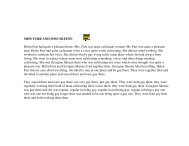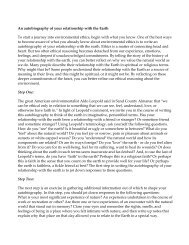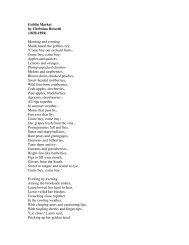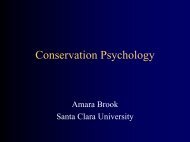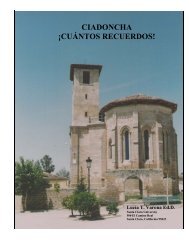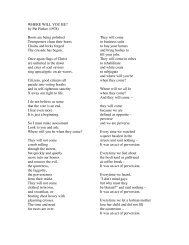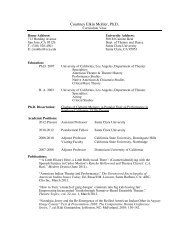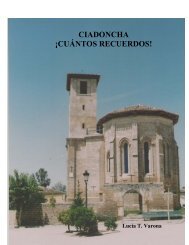ciadoncha; ¡cuántos recuerdos - Webpages at SCU - Santa Clara ...
ciadoncha; ¡cuántos recuerdos - Webpages at SCU - Santa Clara ...
ciadoncha; ¡cuántos recuerdos - Webpages at SCU - Santa Clara ...
Create successful ePaper yourself
Turn your PDF publications into a flip-book with our unique Google optimized e-Paper software.
the animal’s feet would sink and there was nothing to do. During those times they would<br />
make good use of the time by pruning and cleaning the vineyards. They would place<br />
boards over the mud and th<strong>at</strong> is how they would go about cleaning and pruning by hand.<br />
They would take the board and pass it to the other side as they went advancing.<br />
In February they would begin to plow in order to be able to sow the barley l<strong>at</strong>er<br />
on. They would also sow whe<strong>at</strong>, o<strong>at</strong>, alholvas (a legume plant with fluffy leaves and<br />
yellowish seeds th<strong>at</strong> have an unpleasant smell), and hieros. The hieros were legumes th<strong>at</strong><br />
were excellent for the animals. During the bad years, they had to peal them. There were<br />
laborers who did this work in the mornings because when the sun got hot it could not be<br />
done. They had to take advantage of the morning dew so th<strong>at</strong> the straw would not break<br />
and shell.<br />
Luís Pérez sowing. 70s<br />
Photo provided by Federico Varona<br />
A long time ago, the grain was placed in a sack and the two diagonal tips were<br />
tied together and hung over the shoulder. The grain would get picked up with a full fist<br />
and would then be dispersed, making a semi-circumfrence with the edge of the arm<br />
length of the sower. This way the grain was well dispersed. All of this was done <strong>at</strong> the<br />
same time th<strong>at</strong> they took step by step. (Inform<strong>at</strong>ion taken from an email from Arcadio<br />
Varona).<br />
One participant told me th<strong>at</strong> the harvest was in the summer. In those times, they<br />
had to go out to the field <strong>at</strong> one in the morning to collect the nías (in Burgos and<br />
Palencia, this is grain th<strong>at</strong> is cut up and laid out on the ground). They would hook up the<br />
carts to the mules and outside they would go! If there was a moon out, they could see,<br />
but if there was no moon it was darker than a wolf's mouth. And since there were smaller<br />
lands th<strong>at</strong> were in the middle of other people’s lands, many times they would make<br />
mistakes. They would go about happy with their carts, but as soon as soon as it was<br />
dawn, they would realize th<strong>at</strong> they had done someone else’s land. There was no more<br />
than to go discharge the neighbors land and the following day, do their own. All of these<br />
anecdotes were told to me with a lot of humor. They laughed when remembering their<br />
experiences of those times.<br />
137



